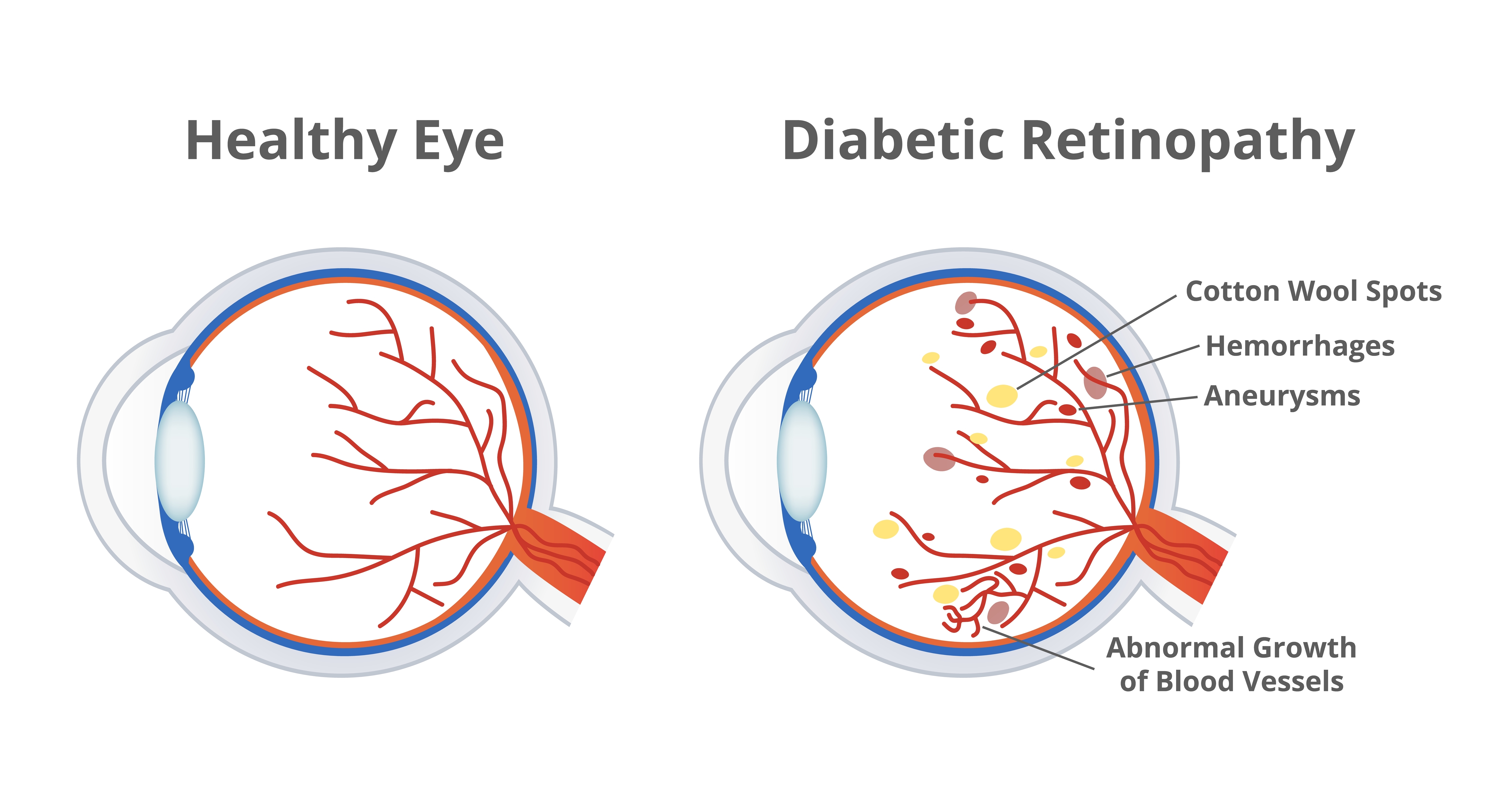Does Diabetic Retinopathy Come with Any Warning Signs?
June 10, 2024
Age-related eye conditions are highly prevalent, especially in adults over the age of 40 with certain pre-existing medical conditions. Diabetes, in particular, puts patients at a much higher risk for eye conditions.
One eye condition in particular is a direct result of diabetes: diabetic retinopathy. Diabetic retinopathy is a serious eye condition that can cause permanent vision loss.
However, there are ways to prevent vision loss from diabetic retinopathy. Unfortunately, there are very few warning signs for diabetic retinopathy, so the best way to treat it effectively is to schedule eye exams regularly with your eye doctor. Keep reading to discover if diabetic retinopathy has any warning signs and what that can mean for your vision.
What is Diabetic Retinopathy?
 Diabetic retinopathy is an eye condition that affects the retina. The retina is the thin membrane that lines the back of the eye and contains special cells called photoreceptors.
Diabetic retinopathy is an eye condition that affects the retina. The retina is the thin membrane that lines the back of the eye and contains special cells called photoreceptors.
Photoreceptors are light-sensitive and send impulses to the brain when light passes through the eye. The brain interprets these impulses as images that can be understood and seen. Without the retina, you wouldn't be able to see at all.
The retina gets oxygen from tiny blood vessels. Because these blood vessels are so small, they're more easily affected by high blood sugar levels.
Since diabetes causes high blood sugar due to lack of insulin, these smaller blood vessels can start swelling and leaking. Diabetic retinopathy is the swelling, leaking, and abnormal growth of blood vessels attached to the retina.
Over time, these blood vessels can damage the retina, eventually leading to vision loss as scarring destroys photoreceptor cells, which cannot regenerate.
What are the Signs and Symptoms of Diabetic Retinopathy?
The primary symptom of diabetic retinopathy is vision loss. This vision loss usually starts with blurry vision and dark or blind spots in your vision.
But these symptoms usually can't be reversed by the time these symptoms appear. Vision loss from diabetic retinopathy is permanent, and while treatment can slow and even prevent further vision loss, it cannot repair any damage already done to the retina.
This is why scheduling eye exams with your eye doctor regularly is so important. However, one symptom of diabetic retinopathy may be treatable.
Sometimes, blood from leaking blood vessels can get into the vitreous, the gel-like substance that fills the eye. Blood may appear in your vision as floaters that look like spider webs.
Floaters can often be removed with a vitrectomy, which removes part of your vitreous. If you start seeing spider web-like floaters in your vision, you should see your eye doctor at Washington Eye Specialists as soon as possible.
Not only may they be able to treat the floaters, but they can also diagnose you with diabetic retinopathy and recommend further treatment. However, the best way to preserve your vision from diabetic retinopathy is to have eye exams to diagnose and catch it early.
You may not be able to perceive early damage to the retina, but it can be seen through an eye exam long before you develop any symptoms. This is how booking eye exams periodically can save your vision.
If you know that you're at an increased risk of developing diabetic retinopathy, you should schedule eye exams more often as well.
Is It Time for an Eye Exam?
What Puts You at Risk for Developing Diabetic Retinopathy?
Having diabetes puts you at risk for diabetic retinopathy, including type 1, 2, and gestational diabetes. But there are additional factors that can increase your risk further, including:
- Poorly managed diabetes
- High blood pressure
- High cholesterol
- Pregnancy (both with gestational diabetes and pre-existing diabetes)
- Using tobacco products
- Being of African, Hispanic, or Native American descent
- Having diabetes for a long time
Most people with diabetes should have their eyes examined at least once a year. But if you're at higher risk for diabetic retinopathy, you may need eye exams more often.
Your eye doctor at Washington Eye Specialists and your primary care physician will be able to tell you just how often you need eye exams based on your medical history.
Can You Prevent Diabetic Retinopathy?
There's no way to prevent diabetic retinopathy, but you can lower your risk. If you have diabetes, the best way to do this is simply by being as healthy as possible.
Keep your blood sugar levels down, eat well, and stay active. But there are many risk factors you can't affect, so you'll always be at risk for diabetic retinopathy if you have diabetes.
The longer you have diabetes, the higher your risk of developing diabetic retinopathy becomes. However, scheduling eye exams can help ensure you don't lose your vision from diabetic retinopathy.
When diagnosed and treated early, you can significantly slow down and even prevent vision loss.
Treating Diabetic Retinopathy
Although there is no cure for diabetic retinopathy, it is manageable with treatment. Treating diabetic retinopathy can prevent or slow damage to the retina.
One standard treatment is medication in the form of injections that help inhibit the growth of new blood vessels. These are called anti-VEGF injections, and when taken regularly, they can prevent the formation of abnormal blood vessels, which in turn prevents swelling and leaking.
Laser treatments can seal off and destroy leaking blood vessels without damaging the retina. Depending on the severity of your case of diabetic retinopathy, your eye doctor may use one or more treatments to manage the condition.
However, treatment is always more effective the earlier the condition is detected, making eye exams crucial.
Do you have diabetic retinopathy? Learn more about this eye condition and how to treat it by requesting an appointment at Washington Eye Specialists in Washington, DC, today!



